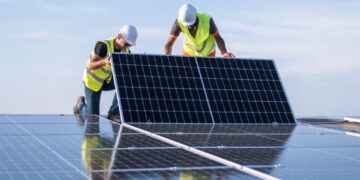By Azuri Technologies
It’s hard to believe sometimes that the Internet is only 25 years old. This change in the way we all live now affects all our lives, to the point where many roles and tasks simply would not happen without it. Starting in the USA as a way of connecting Government research labs, the Internet as we know it has evolved and become, alongside the mobile phone, some of the most universally accessible infrastructure globally.
The technology has followed the traditional path from the US, to major Western capitals and more recently essentially everywhere in most developed nations and widely accessible in the major cities in even some of the least developed nations.
This access to modern technology has been a driver of expansion in many urban areas
The Internet, and mobile technology in general, is often thought of as the great leveller. A tweet is a tweet – it does not take into account your age, income level, where you live, how much education you have had or what you earn.
But while the Internet is a great enabler to those that have access, it serves to widen the gap to those that do not. Today, 1.2 Billion people (roughly one person in 5 on the planet) have no access to mains electricity. That means no TV, no electric light, no computers and even mobile phones (which are largely ubiquitous) have to be charged with a trip to the market. This is not a place to have a data-hungry iPhone that needs charging twice a day!
This lack of infrastructure is a major driver in the urban migration that is common in developing countries. Individuals leave relatively stable lives, where they build their own houses and grow their own food, to move to often crowded and unsanitary high density dwellings, where both housing and food cost money. But people feel driven to do this by the sense that the city is where the opportunity is. It’s the place that has the infrastructure to underpin entrepreneurship. And the increased earning potential is deemed to outweigh the disadvantages.
In Africa today, some 600 million people, mainly in rural areas, lack access to the grid. And this number is increasing as the population of the African sub continent grows by about 3% per year (that’s 30 million new people).
Until a few years ago, the conventional view was that the grid would eventually reach everywhere. That is no longer the case. Governments have come to the view that the grid is ideal for high-density population such as cities but in rural areas, where still around 2/3rds of the population live, another solution is needed.
Fortunately, modern technology is providing some genuine alternatives.
The one thing Africa has in abundance is sunshine. It also has a pretty continuous mobile network (in fact, mobiles have essentially replaced land lines for communication). Bringing together modern solar power, batteries, ultra-efficient
devices (like LED bulbs that use 20 times less energy than a conventional filament bulb) and the mobile phone to allow electronic banking, customers in some of the remotest parts of Africa now have more advanced technology for basic electrical services than you will find in a typical Western household.
This quiet revolution (or “reverse innovation” as it is sometimes known), is allowing rural Africa to skip whole generations of technology such as the grid, TVs with tubes in them, filament lights, land lines for phones and physical branches for banking and adopt the new generation of technology, often well before this technology is available in the West. For example, in Kenya some 40% of the country’s Gross Domestic Product (GDP) passes through one mobile banking application that is accessed using SMS from conventional mobile phones.
There will always be reasons for people to live in cities, just as they do all over the developed world where the infrastructure is essentially universal. But today the economic productivity in rural areas of Africa is way below that in cities (and indeed agricultural productivity is approximately 50% of the global average). Here technology can be transformative.
Starting at the simplest level, solar light replaces kerosene or candles for lighting and provides the ability to charge phones at home instead of travelling long distances to get power. This has a dramatic effect on family life. On average children study up to 2 hours per night extra with solar light and adults report their productive day extends by as much as three hours.
But such simple home power is not electrification, it’s provision of some basic service – a starting point rather than an end point.
The ability to charge phones is also substantial. Individuals have reported spending up to half a day per week just getting phones charged. Now, households can leave their phones on all the time and start using data services that were simply not practical when power was unavailable. In addition, the cost of the solar power is often lower than the kerosene and phone charging costs it replaces.
Next on the list of services is access to media via radio or TV. Rural areas can be very isolated and mainstream media provides a window onto the world that drives expectation, ambition and understanding. Today, solar powered TVs are becoming affordable to rural consumers, delivering satellite TV services into even the remotest home. There is evidence these TVs are having a wide range of positive impacts, including increasing engagement with the political process, both locally and nationally.
This technological revolution is not the end. Nor is it the beginning of the end of rural disparity. But it is a beginning. Technology is becoming more widely accessible and universal. Fundamentally a TV is a TV and a smartphone is a smartphone.
There are expensive and low cost versions of both but they all essentially do the same job. Going forwards the same will be true for a range of appliances from computers to fridges, from social media to e-commerce sites. In this way, many of the barriers to making a successful living in rural areas are being torn down and a new generation of tech-savvy individuals are taking advantage of how technology can enable their lives.
Individuals with motorbike taxis (boda-bodas) can find their customers over instant messaging instead of having to hang around the markets. Farmers can check crop prices in the national markets and ensure the prices offered by local wholesalers are in line and not punitive. And in the future children will be able to study remotely, mothers will have access to e-health and business people will be able to collaborate and trade without consideration of the physical distance or difficulty of travel between places.
All of this, thanks to electrical power and modern digital technology.
For rural consumers the historical one-way traffic has a competitor. Not only are the people moving to the city but also the benefits of the city are coming to a village near you, enriching lives without destroying livelihoods. That sounds like a positive development!























